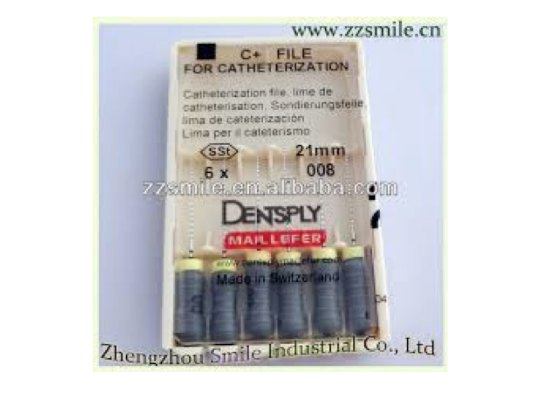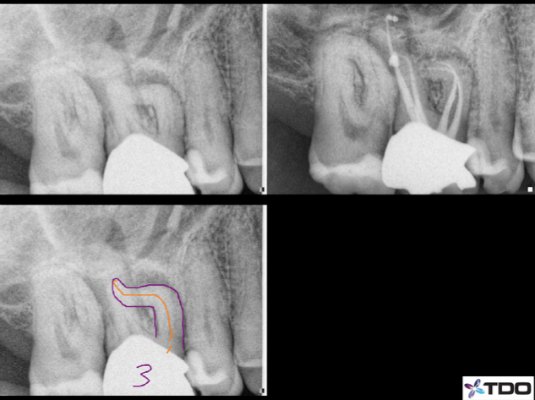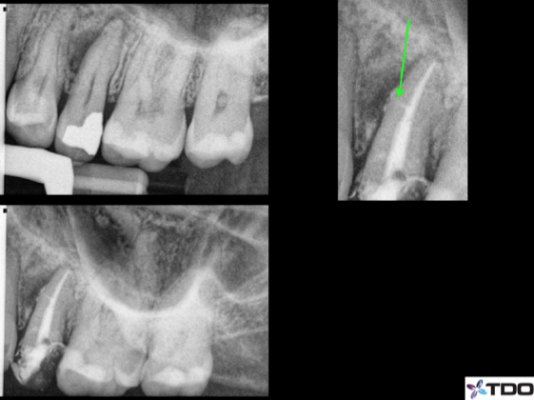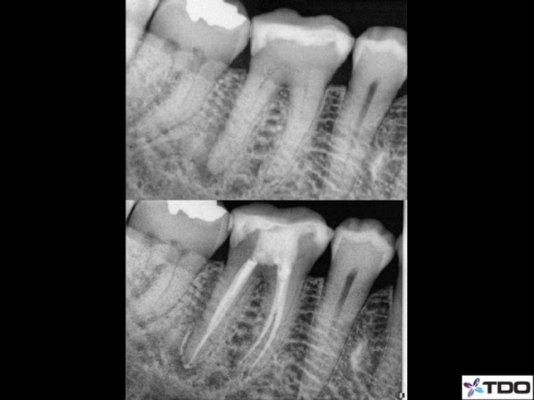C+ Files for Hand Instrumentation…You Gotta Have ’em
I had written a blog a couple weeks ago about creating a glide path for root canal treatment.
The blog outlined some steps and pointers to make this process easier and predictable for regular endodontic cases. However, there will certainly be times where we need to trouble shoot in real time and overcome some hurdles in this process. So I figured I would write a follow-up blog on one particular hang-up can and occur while creating a glide path.
We are hopeful that every canal system we enter will allow a free-flowing drop of a 10 or 15 file to the apex without much effort. That would be endodontic bliss, but unfortunately it is not the reality all the time; certainly not in our office. There are cases that are overly calcified, significantly curved, or have calcific stones in the chamber and deeper in the canal system (figure 1 and 2). A 10 handfile will not drop so easily into the canal to reach the apex without a fair amount of effort to negotiate with smaller or more active handfiles. Even size 8 and even 6 K-file handfiles will not pass through the canal system well. In these situations we will use a C+ handfile (figure 3—Dentsply Maillefer).

Figure 1: Significantly calcified canal system.

Figure 2: Calcific stone in chamber and coronal part of the distal canal (illustrated with yellow arrows).

Figure 3: A pack of size 8 C+ files
C+ files in general are a stiffer file with active end-cutting tip which is quite different from the standard, quite flexible and non-active cutting tips of a K-file. The C+ -file can engage the dentin much better in calcific conditions with the extra stiffness and the active cutting tip, whereas a K-file will simply just “kink” at the tip end when it hits a calcified area. The stiffness is a result of the file having a square cross section which gives it more bulk in the core of the file. The K-file has a triangular cross section.
The C+ -file also comes in the same ISO sizes as standard K-files. In our office we use primarily a size 6 C+ -file. We of course have 8’s, 10’s and 15’s, but the reality is that once a 6 C+ -file reaches the terminus you can then move towards the size 6, 8, 10 K-files as you continue to create the glide path. My suggestion would be to use this type of file in a twist and pull manner rather than a watch-winding or balanced forces technique. You will feel the file engage the dentin and release when you pull the file out. Over and over and over and you will find the file advancing deeper. Sometimes quite slowly, but advancing none-the-less.
Of course as always there are potential pitfalls to using a stiffer and end-cutting handfile such as transportation, ledging, or perforations. So until you have gained a lot of confidence with these handfiles I would not recommend choosing a case that based on the pre-operative radiograph indicates the need for C+ files before starting the treatment (figure 4). Rather use the C+ file when taking on a case that you expected to be fairly regular and fairly straight-forward, but during the glide path phase of treatment you find you need something to work a canal a bit more aggressively to give you a free-flowing path to the terminus (see figure 2 again). For example, single rooted premolars can often be deceiving. Usually these teeth are straight and with relatively open canal systems, but they can be surprising during the treatment and have a tighter canal than anticipated. A size 6 C+ file will likely help negotiate that canal very well (see figure 5). In other words, until you become very comfortable with C+ files, I would suggest using them as back-up instruments rather than expecting to use this file from the start. Over time you will find a lot of comfort with this file and you will advance your endodontic capabilities; taking on more cases. In our office we will use these files in perhaps 80+% of the treatments we provide, but that is simply the type of cases we see on a daily basis and the experience of using these files for many years so that we can limit the possible damaging effects. Keep in mind that in reality these damaging effects are indeed rare.

Figure 4: Just based on the pre-operative x-ray we know that we will be using quite a bit of C+ files based on both curvature and calcification.

Figure 5: While I was expecting this canal to be straight-forward because I can see the canal space clearly and the root is straight, I did need to use C+ files once I had started the case as it proved to be tighter than anticipated.
Additionally, do not be surprised if you need to use many C+ files. Just one or two size 6 C+ file may not allow you to reach the terminus in tight cases. Because the tip engages the dentin the tip can and will unwind thus making it a less effective file. Look at the tip of the file often and if you see unwinding, then grab another C+ file. We have some canals that will require upwards of 20-25 files in a single canal (see figure 6). I would like to employ a hand massage therapist in our office following cases like this. Perhaps if you find yourself in that situation, it might be a reasonable idea to consult with your local endodontic office for a suggestion. But in situations where you simply find a bit more tightness within a canal than expected, you can use these files with quite a bit of success. At minimum keep a fair amount of these files available when needed.

Figure 6: A heavily calcified case which required more than 35 size 6 C+ files to reach the terminus of all 4 canals.
Thanks for visiting Tri City and Fallbrook Micro Endodontics of San Diego, CA.
